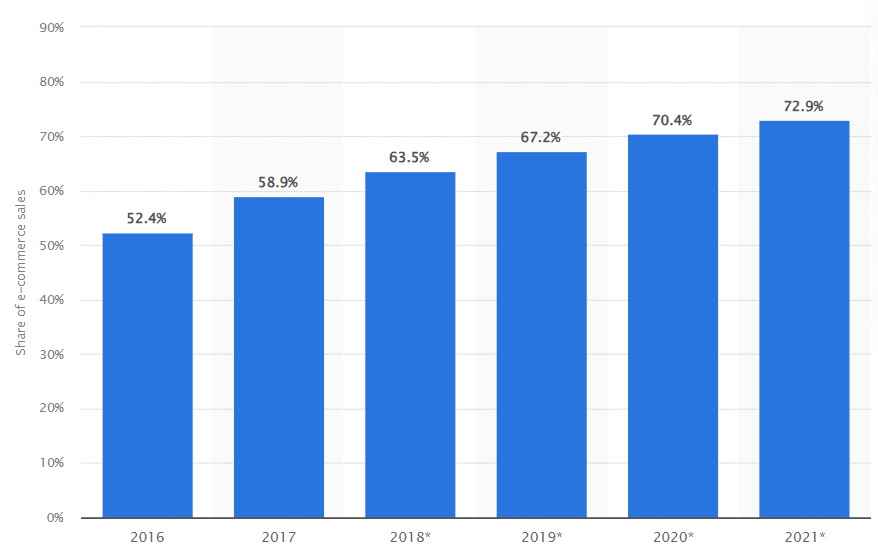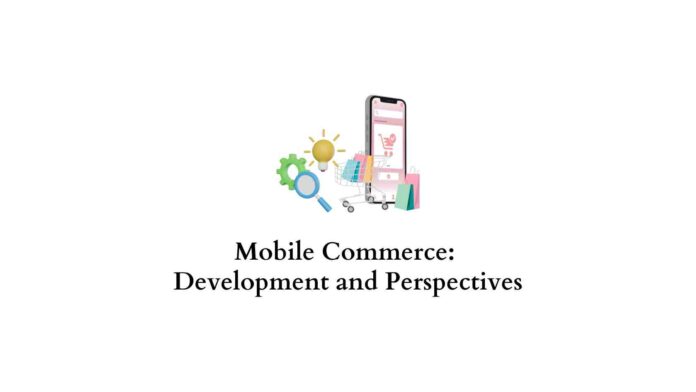Last updated - November 24, 2023
Goods exchange has been developing throughout the whole history of humanity. At the dawn of civilization, there was usually hand-to-hand exchange. As cities developed, large markets emerged where people sold and purchased goods to have everything they wanted. The development of transportation and communication enabled trading between cities and countries, and eventually, the world became interconnected.
The development of the Internet facilitated global commerce by enabling quick connections between buyers and sellers on various platforms, which started to emerge in the 1990s. Online shops, marketplaces, payment systems, and mobile banks started to emerge, changing the way of working with money. In 2023, as we’ll see, it is more unusual not to use mobile commerce apps rather than use them.
Online marketplace app development, therefore, is an actual way to expand your business or enter a large profitable niche. Here, we’ll discuss several types of such applications, their destinations, and missions. Then, you’ll find a short development guide and cost brief to evaluate how you can realize your idea with fewer expenses. Lastly, we’ll wrap the article up by overviewing the m-commerce perspectives and highlighting the key insights. So, let’s start with a short summary!
Summary:
- Mobile commerce includes a variety of applications to proceed with money operations: shops, marketplaces, payment platforms, and mobile banks. They are widely used worldwide, and their numbers rise steadily.
- People and businesses adopt these applications due to their convenience, scaling opportunities, and technical progress that solves problems with security and delivery.
- A good modern mobile commerce app should focus on usability, security, personalization, and customer support to be competitive.
- Testing in all these fields is necessary to ensure that the app will work properly. Target marketing is the best way to attract customers.
- The price of such an application depends on the complexity of its features and may vary from $10,000 to more than $100,000
What is Mobile Commerce?
Applications proceeding with money and payments as their main purpose are all related to mobile commerce. While in-app purchases are now present in most mobile applications, as they often provide paid features to earn money, there are several app classes that are dedicated solely to payments. Let’s review them.
- Shopping platforms are present in several types. Online shops enable people to navigate and buy goods online. There are online services of offline retailers, such as Adidas, and online shop companies operating fully on the Internet, such as Zappos. Marketplaces are large online platforms where people may open their own shops and search for goods from various providers: typical examples are Shopify and Amazon. Both of them provide people with opportunities to buy everything online after which the desired item will be delivered, while marketplaces also enable people to sell their goods and earn money.
- Payment platforms enable users to send and receive money between accounts, facilitating purchasing, selling, and all other money operations. There are many of them, from PayPal to Wise, which help make international payments without days of waiting and tremendous commissions. Other examples are payment services such as Apple Pay and Google Pay, enabling cardless payments using smartphones with NFC chips.
- Mobile banks are apps providing banking options: cards, loans, and money management. They include neobanks operating solely online, such as Revolut and Nubank, and banking apps of various offline banks. People use them to manage their money without visiting bank branches and waiting in queues.
- Mobile ticketing includes apps where customers may quickly buy tickets for movies, theaters, concerts, festivals, or various other events.
So, m-commerce apps include online services of various companies, online businesses, money management and payment tools, and marketplaces. All of them facilitate money operations, despite working in various areas. For example, online shops and marketplaces must cooperate with transportation services or organize courier delivery themselves. Payment and banking platforms must align with financial laws and secure customers’ money.


These apps have disadvantages related to possible safety breaches, but that’s actually the technology and knowledge question. While most financial apps have financial vulnerabilities, millions of people safely use them without risks, and most of these risks are related to social engineering and scams, not direct account hacking. As security develops, m-commerce becomes increasingly safe and convenient, so let’s see some analytics related to this industry and then figure out who usually uses these apps.
A Few Statistics
Let’s start with the evaluation. Shopify provides consistent statistics related to the mobile commerce apps market. Below are three key examples of them.
- In the United States, nearly one-third of all mobile phone users purchased something online in 2021 at least once a week. This number has the tendency to rise.
- Almost 60% of web traffic in the U.S. is mobile
- The m-commerce market size is already more than $600 billion and has the tendency to rise quickly.
Now, see the statistics below to ensure that eCommerce is mostly mobile now, and the tendency is rising, too. While web versions of commerce apps are still necessary, the mobile one is much more actual.


Now you see how actual mobile commerce apps are nowadays and that the actuality will probably rise steadily. The popularity of mobile shopping and payment services is not surprising: they are convenient and easy to use.
Who are These People?
Mobile apps have many advantages, so no wonder people use them more and more. Let’s see these advantages.
- Customers aren’t limited by the necessity to visit a physical shop and have a wide range of purchase options. They can buy everything, which will then be delivered from the closest warehouse.
- They can see prices in various shops and compare them, choosing the least expensive. Also, they have enough time to plan their purchase and, thus, spend money wisely.
- They can see reviews with photo proofs and descriptions of possible problems. They help customers select high-quality items and understand what to do in case of any trouble. Customers can also leave their own feedback.
- Lastly, they are always in touch with the shop via the support center, email, and direct messaging options. It means they can easily obtain any information about the shop’s assortment and answers to all actual questions.
Disadvantages include only possible problems with security and a lack of a specific offline shop atmosphere. Hoverer, there are many ways to ensure privacy and payment safety, and app developers use them. While in the early times of eCommerce, it was an actual issue, now people increasingly use such applications. Possibly, in several decades physical stores will become a kind of relict, used mostly for creating an atmosphere, as people will be able to buy everything online.
As internet technologies and post/delivery services constantly develop, areas of eCommerce, including m-commerce, will continue to rise. Businesses adopt this approach, as it promises endless opportunities for scaling and development.
Why are Businesses so Eager for Them?
All companies that are connected with sales are eager for mobile commerce apps. They include retail companies in all fields: from sports items to bookstores, from grocery chains to consumer electronics. Banks also need them to go online and remain in touch with customers without them needing to visit the physical branch. Let’s see the key opportunities of these apps.
- Convenience for both users and businesses. If you want to sell your goods, you can easily create a list of your goods with photos, descriptions, and prices, which users then select in their shopping cart.
- Customer retention is higher, in case you manage to provide a good user experience. As it’s easier to use a mobile app than go to the shop, a good and usable m-commerce service has a chance to become popular.
- Marketing via the Internet costs much less than offline ads while having a large coverage. It enables businesses to scale quickly, increasing profits, and there are many tools for it available on the Internet.
- Big data includes various analytics and AI tools for customer data analysis, from their preferences to behaviors while visiting the service. They help design target advertising based on user preferences and make better business decisions about sales and money management.
Based on user preferences, mobile commerce app developers decide how to make their products better. Let’s see tendencies in the industry.
Development Tendencies
A good mobile commerce app should provide secure money transfer, a clear user interface, and a robust support center. In addition, good integration with delivery services and refund options is also necessary. Together, these options guarantee that you can actually purchase the desired item or send money safely without any challenges.
- Security is inevitable and basic in all cases where money management is present. If one loses some information, it can be handled, but losing one’s money is much more serious. All m-commerce apps should use modern security decisions and be regularly tested on the subject of breaches.
- User interface and experience is the key to users’ hearts and brains. If they can orient in your app easily and do what they want without bothering and irritation, you have some chances of success. If users are deeply satisfied with how your app shows goods and proceeds requests, your chances are much larger. So, include a good and easy-to-access catalog of your items, a smart search option, lists of favorite items, a shopping cart, and convenient user accounts.
- Content variety is an actual modern trend: use videos to present your goods and show their functionalities. It also includes the usage of modern augmented reality (AR) technologies, enabling users to see the whole 3D images of goods using AR/VR headsets.
- Chatbots and voice assistants will greatly reduce your users’ disappointment when they face any problems, such as the absence of their favorite item or payment problems.
- Personalization based on user behavior analytics includes showing actual recommendations for users. It also helps greatly in marketing and designing relevant and unobtrusive ads. A feedback and review system is also an important element to enable users to express their opinions about goods and services.
- Social commerce includes integration with social media, where customers may share their experience with your app and contact you directly there. As over 40% of them use social media to search for goods, it’s certainly a good place to develop your operations.
These tendencies show you which features are necessary for a good m-commerce app. When speaking about them, it’s mostly about the shopping applications, but everything above relates to payment and banking services too. So, let’s overview what you’ll need to develop such an app and how much it may cost.
Development Brief
Such apps especially require convenience and usability. Start by deciding which mobile commerce app type you’ll build and what you’ll sell via it. After that, create a prototype with the most suitable and usable interface to realize this purpose. It will show you the next step of the development: programming for creating the front-end and back-end sides of the m-commerce app.
Think about technologies that may be helpful here. Artificial intelligence would be good for analyzing customers’ data, personalization, and powering chatbots for customer support. End-to-end encryption and 2-step verification are safety solutions that will decrease the chance that your customers will lose their money.
Lastly, think about which services you’ll need to partner with, such as delivery and payment services. Create a list of them to understand how much money and time you’ll need to do this and how it’ll help you.
Post-Development: Testing and Promotion
After you have the end product, it should be profitable enough to pay off all investments and development expenses and, eventually, generate a stable income. A good marketing strategy is based on attracting customers and ensuring that they’ll remain with you. In addition, test your app for usability, security, and freedom from bugs to ensure it’s working correctly. Here we have several tips for these activities.
- Places to promote: Which social media does your target audience prefer? Which Facebook groups do they read, for example? Based on these answers, you can define where to promote your app using target advertising.
- Payment options: Which of them are typical for your target audience? Make sure to include Google and Apple Pay, and PayPal, as the most popular payment system, will also be available.
- Support options: The more of them available, such as email, phone, chat, and social media, the better it will be for your company.
- Usability test: Explore how users see and perceive the application and whether there are any inconveniences at each step of the interaction, from registering and searching to purchasing and payment method adding.
- Security test: Research the security of the app’s code and payment gateways to ensure that no hidden flaws and breaches are present, as malefactors may search for them too.


Taking all these activities, let’s try to estimate how much it’ll cost you.
Cost Brief
Mobile commerce app development costs mostly depend on your developers’ hourly rates, all necessary subscription prices, and testing/maintenance expenses.
These apps are very diverse. You may want to develop a simple small online shop or a large banking app: While the former will probably cost you no more than $30,000, the latter’s overall cost may be more than $100,000.
To evaluate the final cost, you need to explore features you want to include in your app, such as payment gates, user profiles, integrations with CRM systems and social media, and artificial intelligence tools. Each additional feature will add $5,000 – $50,000 to the final price, depending on its complexity. In addition, evaluate the hourly rates of your developers: depending on their region and proficiency, they may vary from $15 to $80.
Having the list of all necessary features, hourly rates, and planned development schedules, you’ll calculate the approximate development cost with a large precision!
Perspectives and Conclusion
The importance of m-commerce is based on its usability and convenience. The industry relies on Internet technologies, delivery services, and security decisions, while the development of artificial intelligence also enhances it greatly. If all of these industries will continue to rise, then m-commerce will rise with them.
Mobile commerce is a vibrant and developing industry covering a wide range of services. From specialized shops of diverse item categories to payment apps, all of them are based on money exchange and require robust user experience, support centers, and strong security solutions.
If you develop a successful m-commerce app, you’ll contribute to the more convenient world of the future, so it’ll certainly be a good deed!











